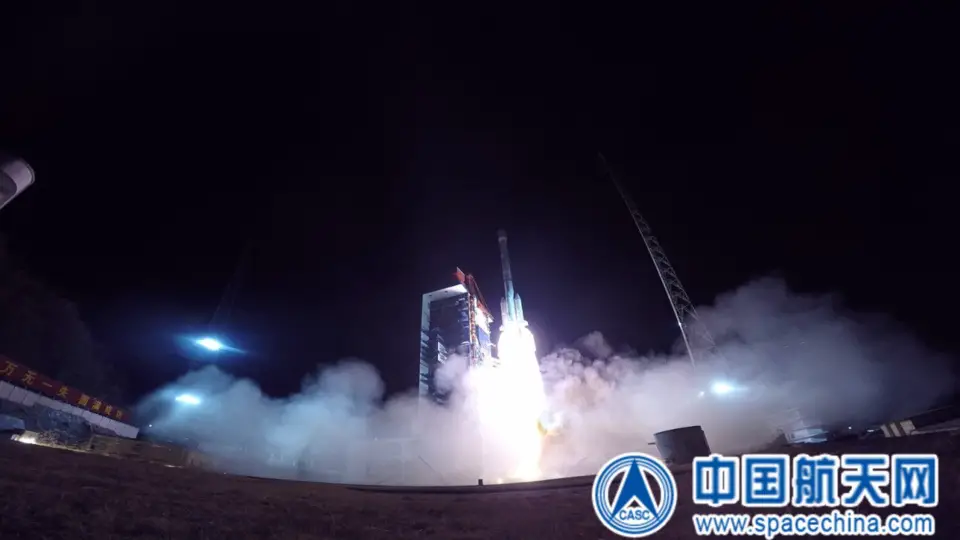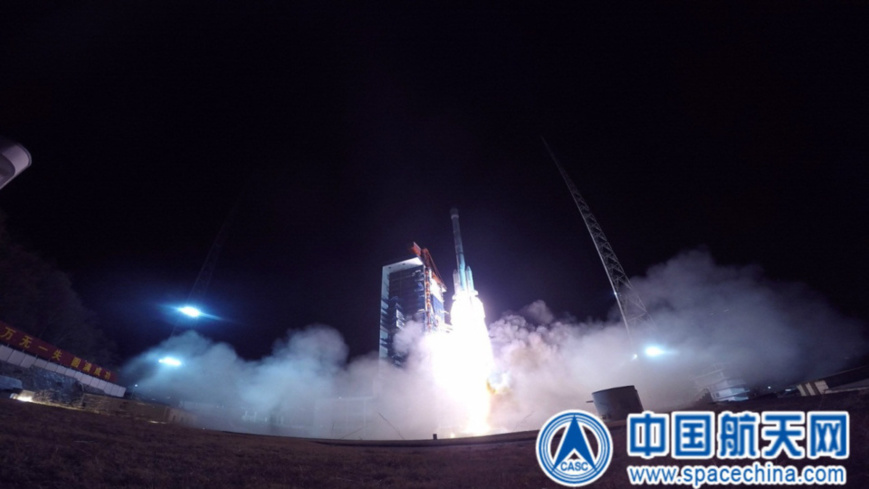By Yu Jianbin from People’s Daily
A communications satellite ChinaSat-6C was sent into preset orbit from southwest China’s Xichang Satellite Launch Center by a Long March-3B carrier rocket at 0:28 a.m. Beijing Time, March. 10.
It was the 300th mission of the Long March carrier rockets and an important historical moment for China's aerospace development.
The first carrier rocket of the Long March family was launched on April 24, 1970, and the 100th rocket Long March-3A carrying the satellite SinoSat-3 was sent into space on June 1, 2007. It took China 37 years to complete the first 100 rocket launches and each year 2.7 launches on average took place.
The country’s 200th rocket launch took place on Dec. 7, 2014, as the Long March-4B carrier rocket was sent into space, carrying a China–Brazil Earth Resources Satellite. It was seven and a half years for the country to complete the second 100 rocket launches. In this period, 13.3 launches on average took place per year.
The 300th launch, the latest one, is only less than five years from the 200th launch. In this period, 23.5 launches on average took place.
The cycle for each 100 launches has become shorter and shorter, which not only indicates that frequent launches of the Long March carrier rockets have become regular acts, but also reflect the rapid development of the country’s aerospace industry, science and technology, and comprehensive national strength.
The Long March carrier rockets, developed by China Aerospace Science and Technology Corporation, are responsible for 96.4 percent of China’s launch missions.
Since the first flight in 1970, the rocket family has put 506 spacecrafts into preset orbits, or 99.2 percent of the country’s total spacecrafts in orbit.
The country has been upgrading the structure and carrying capacity of its launch vehicles over the years. From satellites, manned spacecrafts to lunar probes and from active carrier rockets to the new-generation carrier rockets, China has led the world in lifting capability and orbit injection accuracy.
Statistics showed that China’s success rate of 300 launches stands at 96 percent. Compared with the first 50 launches, the success rate of the rest 250 is higher and more stable.
The Long March carrier rockets has put 225 spacecrafts into orbit in the third 100 launches, pushing the success rate up to 97 percent, which is an extraordinary performance even in the world.
In 2018, China sent 37 rockets into space in a row, topping the world for the first time. The figure was also a global record for almost 20 years regarding the number of consecutive successful launches in a single year.
Reports confirmed that China is now proceeding smoothly as scheduled with the research and manufacturing of new-generation medium-lift launch vehicles, including Long March-6A, Long March-7A, and Long March-8.
Long March-5B, a new-generation carrier rocket with the biggest low-Earth orbit carrying capacity, is under test. It will send modules in orbit for building the country’s space station.
China has carried out a comprehensive debate on the implementation of the launch of a heavy-lift carrier rocket, which is expected to have a maiden flight by around 2030.
In the future, the country will innovate the way carrier rockets reach and leave space, as well as space transportation, through developing a reusable space transportation system, and combining space transportation with space operations.
It was the 300th mission of the Long March carrier rockets and an important historical moment for China's aerospace development.
The first carrier rocket of the Long March family was launched on April 24, 1970, and the 100th rocket Long March-3A carrying the satellite SinoSat-3 was sent into space on June 1, 2007. It took China 37 years to complete the first 100 rocket launches and each year 2.7 launches on average took place.
The country’s 200th rocket launch took place on Dec. 7, 2014, as the Long March-4B carrier rocket was sent into space, carrying a China–Brazil Earth Resources Satellite. It was seven and a half years for the country to complete the second 100 rocket launches. In this period, 13.3 launches on average took place per year.
The 300th launch, the latest one, is only less than five years from the 200th launch. In this period, 23.5 launches on average took place.
The cycle for each 100 launches has become shorter and shorter, which not only indicates that frequent launches of the Long March carrier rockets have become regular acts, but also reflect the rapid development of the country’s aerospace industry, science and technology, and comprehensive national strength.
The Long March carrier rockets, developed by China Aerospace Science and Technology Corporation, are responsible for 96.4 percent of China’s launch missions.
Since the first flight in 1970, the rocket family has put 506 spacecrafts into preset orbits, or 99.2 percent of the country’s total spacecrafts in orbit.
The country has been upgrading the structure and carrying capacity of its launch vehicles over the years. From satellites, manned spacecrafts to lunar probes and from active carrier rockets to the new-generation carrier rockets, China has led the world in lifting capability and orbit injection accuracy.
Statistics showed that China’s success rate of 300 launches stands at 96 percent. Compared with the first 50 launches, the success rate of the rest 250 is higher and more stable.
The Long March carrier rockets has put 225 spacecrafts into orbit in the third 100 launches, pushing the success rate up to 97 percent, which is an extraordinary performance even in the world.
In 2018, China sent 37 rockets into space in a row, topping the world for the first time. The figure was also a global record for almost 20 years regarding the number of consecutive successful launches in a single year.
Reports confirmed that China is now proceeding smoothly as scheduled with the research and manufacturing of new-generation medium-lift launch vehicles, including Long March-6A, Long March-7A, and Long March-8.
Long March-5B, a new-generation carrier rocket with the biggest low-Earth orbit carrying capacity, is under test. It will send modules in orbit for building the country’s space station.
China has carried out a comprehensive debate on the implementation of the launch of a heavy-lift carrier rocket, which is expected to have a maiden flight by around 2030.
In the future, the country will innovate the way carrier rockets reach and leave space, as well as space transportation, through developing a reusable space transportation system, and combining space transportation with space operations.
 Menu
Menu
 China completes 300th launch of Long March carrier rockets
China completes 300th launch of Long March carrier rockets

















